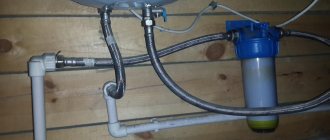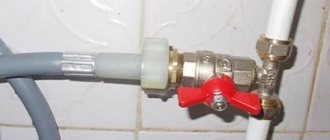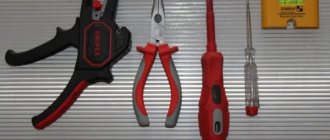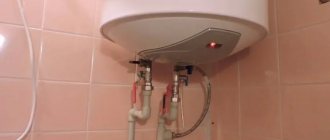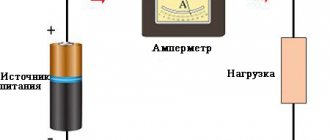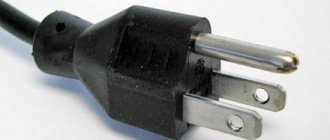The situation is quite common: you turn on the electric heater, after the usual time you open the hot tap, but the water is cold. This may or may not be accompanied by additional symptoms:
- The power indicator (heating, turning on the second circuit) does not light up;
- the boiler generates an electric current through the water (if it is not grounded, this is not necessarily a sign of a malfunction);
- Water is dripping (pouring) from the water heater;
- unusual sounds are heard inside the case;
- there is a smell of burnt wiring around the electric water heater;
Diagnostics: how to recognize a breakdown yourself
The first step is to make sure that the boiler is not heating water due to internal failure. To do this, rule out other possible problems:
- Check for electricity in the house.
- Look at the position of the circuit breaker to which the device is connected. The water heater consumes a lot of energy, which may cause the network overload protection to trip.
- Inspect the outlet and electrical plug, which may have burned out due to high voltage.
If the problem is electrical, ask a specialist to check the condition of the wiring, eliminate the faults and redistribute the load on the network. Is your home electrical supply ok? Then check out the list of warning signs below.
Types of breakdowns and causes
The boiler does not heat the water, the lamp is on
If you notice that the boiler has stopped coping with its direct responsibilities, the problem may lie in a faulty thermostat, which affects the operation of the heating element, or in the heating element itself. In the second case, the problem is most likely scale: it covers the tubular electric heater and reduces its efficiency. This may also be indicated by the fact that the device takes a long time to turn on or turns off frequently.
The situation will be saved by replacing the part or thoroughly descaling. If filters are not installed in the house, the heating element should be cleaned before the first warning signs appear - preferably once a year. We advise you to seek help from a qualified technician: in order to clean the element, you need to disassemble the device - this requires plumbing skills.
How to avoid this?
Don't want to clean your water heater every year? Be proactive: install water filters!
- If you are concerned about the quality of the water in general, install a main filter. It cuts directly into the water supply and household appliances, including the water heater, use the already filtered water. This solves the scale problem at its root. A mainline cleaning system is a good investment for several other reasons:
- Purifies all water in an apartment or house.
- Productivity reaches 50 l/m.
- The filter properties vary depending on the installed cartridge. You can buy replacement modules for mechanical, ionic, sorption purification or special-purpose cartridges and choose the type of filtration that is right for you.
- With proper use, the filter will last more than 10 years. Just don't forget to change the cartridges!
- Install a softener or appliance pre-filter if the water quality seems acceptable and you simply want to save time and money on boiler maintenance. These devices are designed for technical filtration of water entering a specific household appliance:
- They consist of a sealed body and a special backfill, which, when dissolved, removes hardness salts and heavy metal impurities from the liquid. The content of the filter must be updated promptly.
- Not as effective as main filters, but they extend the life of a water heater or washing machine by 3–5 years.
Source
Solving the situation
Reliable and long-term operation of equipment - correct and competent installation of units in accordance with established requirements and standards. During the operation of water heaters, various breakdowns, malfunctions or unpleasant situations can often occur that impede the normal operation of the equipment. A competent and comprehensive approach will allow you to solve the problem yourself, without resorting to the help of a specialist.
Only timely maintenance and cleaning guarantee the safety of the equipment.
Watch also the video on how to repair a leaking water heater.
What to do to correct the situation
If the boiler does not heat, the light does not light, follow these steps:
- Check whether its plug is plugged into the outlet.
- Press down on the plug to make sure the connection is secure.
- Plug in another household appliance (table lamp, hair dryer, mixer) to check the power supply.
- Press the safety device off button, then the power button. The indicator on the RCD body should light up.
- Turn the thermostat knob to the maximum setting.
- If you have skills in servicing electrical appliances, check the thermal cut-off: disconnect the heater from the mains, remove the protective cover, press the thermal protection button on the emergency thermostat, and plug it in.
If, after all the actions taken, the boiler still does not heat, the light does not light , or the automation still constantly works, call a water heater repair specialist from the service center.
How to avoid repeated breakdowns
After the technician finds out why the boiler stopped heating water and repairs it, follow these recommendations:
- Every year, order cleaning of the tank and heating element from the service center and replacement of the magnesium anode. Due to poor quality water, the metal becomes overgrown with scale, and the anode dissolves.
- If the water heater is equipped with an electronic control module, and periodic power surges are observed in the electrical network, use a voltage stabilizer or relay (“barrier”).
- Set the economical water heating mode to +55-60°C. Some manufacturers mark it with the letter “E”.
- If there is strong water pressure in the main, install a pressure reducer so that it does not burst the internal tank.
If the boiler does not heat, the light does not light up, and you cannot determine the malfunction,
call our service center!
Write a review Your Name:
Your feedback:
Attention: HTML is not supported! Use plain text.
Source
A separate procedure is replacing the heating element
This is necessary when a malfunction of the heater is clearly established, or if its mounting flange has leaked. In any case, it won’t hurt to inspect the internal space of the boiler. At the same time, you can clean the heating element from scale.
Of course, this situation is only possible with very calcined water. However, even normal water hardness, as well as ignoring maintenance, will turn your heater into a useless piece of iron.
Tip: if you get to the heater, it’s a good idea to check the condition of the magnesium anode. It is located next to the heating element.
Causes of breakdowns of storage water heaters
If your boiler has stopped heating water, the very first thing you need to do is figure out whether power is being supplied to the device. It is necessary to check whether there is a contact in the cable connecting the electric storage water heater
with a socket or electrical panel, depending on how your connection is made.
You can test the wire using an indicator screwdriver or tester by ringing its ends. The indicator should light up at “phase”, at “zero” and “ground”; in a working wire there is no signal. Cause
The lack of power may also lie in the outlet itself; this can be checked by connecting any other working device to it.
If it is faulty, most likely the outlet parameters do not match the power of the device. It is necessary to check whether the fuse is blown; this can happen when several high-power devices are connected at the same time. Then you need to check the contact of the cable with the terminals on the water heater; after a certain time, it may weaken or the connection may burn out. If there is no electrical power supply to the device, the indicator will not light up
Everything is fine with the power supply to the unit, but the electric storage water heater does not heat up and light does not light up? Cause
hides in the malfunction of the internal components of the water heater. To detect and correct the problem, turn off the heater and drain the water from it. Then the housing casing is removed from the boiler, and parts are taken out for inspection.
When a storage electric water heater
stopped
heating
the water, you need to check the serviceability of the thermostat. To monitor its performance, a tester is used; its contacts are connected to the contacts of the thermostat. If the device shows voltage, to restart you need to press the thermostat start button.
Testing the performance of the thermostat
Turning on happened, which means the device turned off due to the reason for the thermal protection tripping. Why does the thermal protection trigger in the unit? After heating the water above ninety degrees, the protection turns off the device. This can also happen due to the presence of a thick layer of scale on the heating element; to eliminate the problem, you need to clean the scale on the tubular heater.
If the thermostat does not turn on after pressing the thermal protection button, the thermostat is most likely faulty and needs to be replaced with a new one.
In the absence of heating of the boiler, the breakdown of the heater often becomes the cause. The average operating life of a tubular heater will be approximately four years. If you do not change the anode in time, this period can be noticeably reduced.
The serviceability of the tubular heater is examined by a tester, the resistance at the contacts is measured, if there is no resistance, the tubular heater is faulty. When the boiler seems to be working, light is on, but slowly and weakly heats the water, it is necessary to clean the TENA and the tank from scale.
Checking the Tubular Heater
Moreover, a breakdown occurs on the housing, which can also be detected using a tester. When a breakdown occurs, the RCD is triggered. In both cases, it is impossible to repair the tubular heater; it must be replaced. When purchasing, a component with similar parameters is selected.
Leak in tank
The problem of leak development is associated with corrosion of the metal, which is constantly in contact with water. If you do not change the magnesium anode, as required by the manufacturer, then after a couple of years you can see clear signs of depressurization. In 95% of cases, it will not be possible to eliminate this problem, since the design of the tank requires tightness, which can only be achieved in a factory environment.
A leak in the tank is almost impossible to fix on your own; a complete replacement may be required.
Self-repair is only appropriate if the leak appears exclusively from under the flange. This happens when the gasket, which creates a seal on the outside of the heating element, is worn out.
The sequence of actions in this case is as follows:
- Disconnect the boiler from the mains, let the water cool and drain it as much as possible.
- Remove the lid, place the container and carefully open the valve, removing it along with the heater.
- Inspect the rubber valve for deformations and abrasions.
- Replace it by first disconnecting it.
If drops of water collect along the contour at the bottom of the boiler, then this cannot be corrected. Craftsmen will tell you that there is also welding that will allow you to quickly and reliably seal the hole. But this is inappropriate in the case of closed-type boilers, since the design does not imply access to the outside of the internal tank. It would be appropriate to replace the water heater with a new one.
Why does the flow-type heater not work?
If the instantaneous water heater does not work, the first thing you need to do is also check the power cord. Flowers generally have higher power than storage devices.
For continuous operation, the connection must be made with a cable with a cross-section of at least 4 square meters. mm, with a power of 5 kW a separate 30 A circuit breaker is connected, from 7 kW - 40 A. Otherwise, your EVN will work for a short time. It is necessary to check the serviceability of the Residual Current Device by pressing the “Test” button on it; the serviceable Residual Current Device should turn off. It will be useful to check the strength of the connection of the wires on the shield.
A malfunction of the tubular heater in the flow duct very often occurs due to low supply water pressure, when the pressure meter does not have time to operate, the heating element burns. Also, if the design of the EWH is designed in the same way that the tubular heater is in direct contact with water, and not in a protective flask, salts may corrode the surface of the TENA.
Tubular instantaneous boiler heater
Poor installation of the device also turns out to be the basis for burnout; it must be carried out strictly in accordance with the manufacturer’s advice, since changing the installation angle leads to the fact that the thermostat probe does not come into contact with the spiral, and it burns out. Under any circumstances, the heater itself is very often changed, since the cost of a tubular heater is not significantly less than the cost of an EWH.
A breakdown of the boiler pressure sensor is often considered to be the reason why your device does not turn on. An important element of this sensor is a rubber membrane fabric, which, under the pressure of passing water, turns on a microswitch. During operation, it can stretch and tear due to the side effects of salts in the water. In this case, it needs to be replaced; it is better to buy a silicone one, it will last longer.
The temperature sensor can also cause a breakdown. To determine its performance, call its contacts; if there is no signal, the meter is faulty and cannot be repaired.
Water temperature sensor
The EWH may also not work due to the fact that the contacts at the connecting points of the wires with the terminals very often burn out on flow machines. Sometimes you need to check the stability of connections and tighten loose contacts.
Source
Causes of storage boiler malfunctions
If your water heater stops heating water, the very first thing you need to do is figure out whether power is being supplied to the unit. Check if there is a contact in the cable connecting the boiler to the socket or electrical panel, depending on how you made the connection.
You can test the cable using an indicator screwdriver or tester by ringing its ends. The indicator should light up on “phase”, on “zero” and “ground”; in a working wire there is no signal. The reason for the lack of power may lie in the outlet itself; this can be checked by connecting any other working device to it.
If it is faulty, most likely the outlet parameters do not match the power of the device. Check if the fuse is blown; this can happen when several high-power devices are connected at the same time. Then check the contact of the cable with the terminals on the water heater; it may weaken over time, or the connection may burn out. If there is no power supply to the unit, the indicator will not light up.
Is everything in order with the power supply to the unit, but the storage boiler does not heat up and the indicator light does not light up? The reason lies in the breakdown of the internal elements of the boiler. To identify and eliminate the breakdown, turn off the power to the heater and drain the water from it. Then the housing casing is removed from the water heater, and parts are removed for inspection.
When the boiler stops heating water, you should check the functionality of the thermostat. To check its performance, a tester is used; its contacts are connected to the contacts of the thermostat. If the device shows voltage, to restart you need to press the thermostat start button.
Testing the performance of the thermostat
The switching on occurred, which means that the unit turned off due to the thermal protection tripping. Why does the thermal protection trigger in the unit? After heating the water above ninety degrees, the protection turns off the device. This can also happen due to the presence of a thick layer of scale on the heating element; to eliminate the problem, you need to clean the deposit on the heating element.
If the thermostat does not turn on after pressing the thermal protection button, the thermostat is most likely faulty and should be replaced with a new one.
If the water heater does not heat up, a common cause is a malfunction of the heating element. The average service life of a heating element is about four years. If you do not change the anode in a timely manner, this period can be significantly reduced.
The serviceability of the heating element is checked with a tester, the resistance at the contacts is measured, if there is no resistance, the heating element is faulty. When the water heater seems to be working, the indicator light is on, but it heats the water slowly and weakly; it is necessary to clean the heating element and the tank from scale.
Checking the heating element
In addition, a breakdown occurs on the housing, which can also be detected using a tester. In the event of a breakdown, a protective shutdown device is triggered. In both cases, it is impossible to repair the heating element; it must be replaced. When purchasing, an item with similar parameters is selected.
Leaking units
The first most common breakdown is a water heater leak. This situation is one that should be addressed immediately. What to do when the boiler leaks depends on the source. Initially, you need to establish the cause of this problem. They may be:
- Technological violations committed during the installation process, especially when installation is carried out without the help of specialists. In this case, water drains from under the plastic cover or from under the plugs.
- Lack of maintenance, in particular, cleaning the tank, which leads to failure of the heating element (heater). Due to poor water quality, scale is deposited on this part. This is the reason why the boiler dumps water.
- Formation of corrosion processes. Even with high-quality protection, it will not be possible to avoid this, and it is not always possible to control stray currents, which increase the resistance of elements to such phenomena.
- Incorrect grounding or missing part, as well as an overpressure relief valve.
As practice shows, the leak begins unnoticed. The main cause is usually corrosion of the internal surface. What to do if the boiler is leaking? There are two options: repair it immediately or buy a new boiler.
It is safer to fix such a problem by calling a specialist. But initially you should disconnect the device from the network before draining the water from the boiler. In the latter case, you will need a special hose to complete the work. The liquid must be drained when water heaters with a heating element or magnesium anode require replacement of these elements.
How to pour water from the boiler correctly is indicated in the instructions, so you need to study all the subtleties and nuances, because each brand or model is different.
A leak is most often caused by corrosion or a hole in the heater tank. Many people are interested in how to weld a boiler that is leaking, trying to fix the situation on their own, but it should be noted that it is absolutely impossible to carry out such work yourself. Otherwise, it will cause the tank to rupture and cause harm to health.
When water drips from the safety valve during the heating process, this cannot be considered a problem. This picture is associated with the expansion of the liquid and the creation of excessive pressure. But if too much leaks out - 1.5 liters per day, or the valve is too dry, then the element has become unusable and requires replacement.
How to repair a boiler tank:
- disconnect the unit from the network, which will not cause any problems;
- drain the liquid;
- disassemble the device;
- disconnect the fastons that connect to the thermostat;
- unscrew the bolts (usually there are six of them);
- remove the heating element, while a certain amount of liquid remaining in the tank is still poured out;
- clean the components.
It is also recommended to replace the magnesium alloy pin (anode) at the same time.
The installation is reassembled in reverse order and checked to see if the problem has been resolved. We must not forget that you first need to fill the container with water and only then connect the unit to the network when starting up. When the problem is more serious, the tank must be replaced.
